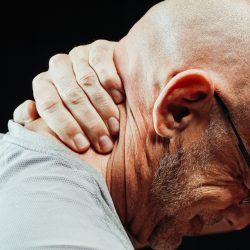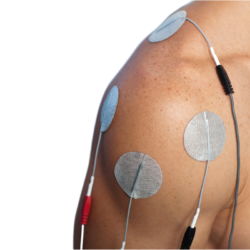Precordialgia, a term that may seem complex at first glance, refers to a very real reality for those who experience it: pain in the precardiac region, i.e. in the left anterior-lateral part of the thorax, just in front of the heart. This sensation, which can range from mild discomfort to acute pain, often gives rise to understandable concern. What causes this pain? Is it a sign of a serious heart problem? And above all, how can we effectively relieve this pain that disrupts everyday life?
What is precordialgia?
Precordialgia is characterised by chest pain which, despite its proximity to the heart, is not necessarily a symptom of heart disease. It should be distinguished from heart pain such as that caused by angina pectoris, which is not relieved by conventional treatments such as nitroxide. It can be acute or more diffuse, affecting the well-being and daily lives of those concerned.
The importance of pain management
Tackling precordialgia is not just a matter of comfort; it is a necessity for preserving quality of life. Left untreated, it can lead to stress, anxiety and fear, including the fear of suffering from serious heart disease. However, homeopathy, with its range of specific remedies, is proving to be an invaluable ally in the quest to relieve this pain, whether it manifests itself as burning, squeezing or even a vice-like sensation. Understanding and treating this pain is essential to maintaining a healthy and reassuring life balance.
Understanding precordialgia
To approach the relief of precordialgia, it is essential to understand its contours, causes and manifestations. Precordialgia has a variety of causes, including muscular lesions (particularly of the intercostal muscles), skin lesions (such as those caused by shingles), bone pathologies affecting the sternum and ribs, pleural or mediastinal damage, not forgetting stress as a potential trigger.
Common causes
Precordialgia can have many causes: emotional stress, musculoskeletal disorders such as Tietze’s syndrome (inflammation of the cartilage that joins the ribs to the sternum), gastro-oesophageal pathologies such as gastro-oesophageal reflux, or pulmonary anomalies. This diversity of causes makes diagnosis complex and underlines the importance of a personalised approach to pain relief.
Identifying precordial pain
Characterised by variable intensity, precordialgia pain can be distinguished by its precise location and its independence from respiratory movements or physical effort. It can radiate to the jaw, neck, left arm and even the back, distinguishing itself from cardiac pain by its ability to be precisely localised by the patient.
What are the associated symptoms?
In addition to chest pain, precordialgia can be accompanied by palpitations, shortness of breath, burning sensations and even dizziness. These associated symptoms vary from person to person, making the experience of precordialgia unique to each individual.
What are the natural methods of relief?
When faced with precordialgia, many people turn to natural therapeutic solutions in search of relief without the potential side-effects of conventional drug treatments.
The importance of natural remedies
In a world where traditional medicine plays a dominant role, natural remedies offer a valuable therapeutic alternative or complement. Their less invasive approach and their active ingredients, often derived from nature, allow us to look at treatment from a different angle, one that is gentler and more respectful of the body.
Phytotherapy for precordialgia
Nature offers us a rich and varied pharmacopoeia, capable of helping those suffering from precordialgia. Phytotherapy, or the use of plants for medicinal purposes, offers several options:
- Chamomile: known for its calming and anti-inflammatory properties, chamomile can help relieve chest pain linked to stress or gastro-oesophageal disorders.
- Ginger: in addition to its benefits for digestion, ginger has anti-inflammatory properties that can be beneficial for precordial pain.
- Lemon balm: often used for its relaxing effects, lemon balm can help reduce anxiety and stress, factors that can exacerbate precordialgia.
These plants can be taken in various forms, such as herbal teas, capsules or essential oils, depending on individual preferences and the advice of a healthcare professional.
Nutritherapy and anti-inflammatory diet
Diet plays a key role in managing precordialgia, particularly by reducing inflammation in the body. Eating a diet rich in natural anti-inflammatories can help prevent and relieve pain:
- Omega-3s: found in oily fish such as salmon, omega-3s are known for their beneficial effects on cardiovascular health and their anti-inflammatory properties.
- Colourful fruit and vegetables: rich in natural antioxidants, they help fight inflammation and boost the immune system.
- Spices: turmeric, ginger, etc. These spices are not only tasty allies in the kitchen, they are also powerful natural anti-inflammatories.
Incorporating these foods into your daily routine can be an effective strategy for managing precordialgia naturally.
How can precordialgia be treated with homeopathy?
The homeopathic approach, with its gentle and personalised nature, offers a route to relief for those affected by precordialgia. Based on the specific symptoms of each individual, homeopathy offers remedies capable of targeting and effectively reducing pain. Frequently recommended remedies include :
- Arnica montana Boiron: often used for pain resulting from trauma or bruising. This homeopathic strain may be indicated for chest pain caused by trauma.
- Bryonia alba Boiron: suitable for pain that worsens with movement, relieving acute chest pain.
- Rhus toxicodendron Boiron: suitable for pain that improves with movement, often used for muscle pain.
- Aconitum napellus Boiron: ideal for sudden, intense pain, often aggravated by cold and anxiety. Mainly recommended at the onset of symptoms.
- Ignatia amara Boiron: specially indicated for pain linked to stress or emotion.
Although precordialgia is not directly linked to cardiac conditions, it does require attention and appropriate treatment. Thanks to its ability to offer personalised solutions with no significant side effects, homeopathy is a therapeutic method of choice. However, it is essential to consult a healthcare professional for a precise diagnosis and a treatment plan tailored to your specific needs. With its gentle, targeted approach,homeopathy can offer significant relief and help improve the quality of life of people suffering from precordialgia.
What complementary therapeutic practices are there?
In addition to natural remedies, certain practices can effectively complement the treatment of precordialgia, in particular by tackling its underlying causes, such as stress.
Relaxation and stress management techniques
Precordialgia is often linked to stress, so relaxation techniques such as meditation, yoga or regular deep breathing can be very beneficial. These practices help to reduce stress and anxiety levels, thereby reducing the intensity and frequency of chest pain.
Appropriate physical exercise
Physical activity is an essential pillar of general health, and it also plays a role in managing precordialgia. Regular activity, adapted to your abilities and needs, can improve your cardiovascular health and reduce stress. Gentle exercise such as walking, cycling or swimming is particularly recommended.
When should you consult a professional?
Identifying the right time to consult a healthcare professional, such as your online pharmacist, is crucial in managing precordialgia. Although many precordial pains can be managed with natural approaches, certain signals should not be ignored.
Recognising the warning signs
It is essential to know when chest pain requires immediate medical assessment. Consult a healthcare professional if you experience :
- Sudden, intense pain that does not improve with rest.
- Pain accompanied by shortness of breath, sweating, nausea or dizziness.
- Pain that spreads to the arm, jaw or back.
- A feeling of pressure or crushing in the chest.
These symptoms may indicate more serious conditions requiring urgent medical attention.
The role of the specialist pharmacist
Your pharmacist, especially if he or she specialises in natural medicines, can be a valuable resource. They can advise you on appropriate natural remedies and refer you to a doctor or specialist if your symptoms require it. Don’t hesitate to consult your pharmacist to discuss the different natural treatment options and find the one that’s best for you.
Preventing precordialgia
Prevention plays an essential role in the long-term management of precordialgia. Adopting a healthy lifestyle can help reduce the frequency and intensity of painful episodes.
Healthy lifestyle habits
A holistic approach to health can make a significant contribution to preventing precordialgia:
- A balanced diet: eat a diet rich in fruit, vegetables, whole grains and lean proteins. Limit processed foods, added sugars and saturated fats.
- Regular physical activity: exercise helps to maintain a healthy weight, reduce stress and improve cardiovascular health. Find an activity you enjoy and make it part of your daily routine.
- Stress management: adopt relaxation techniques such as meditation, yoga or breathing exercises to help manage everyday stress.
- Quality sleep: make sure you get enough sleep every night. Quality sleep is essential for physical and mental health.
Regular monitoring and self-assessment
Listen to your body and pay attention to the signals it sends you. If you notice any changes in the frequency or intensity of precordial pain, don’t hesitate to consult a healthcare professional. Regular monitoring of your state of health can help you to identify potential problems quickly and take appropriate action.
Frequently asked questions about precordialgia
Precordialgia, with its many facets and causes, requires a careful, personalised approach. Natural methods of treatment and prevention, combined with a healthy lifestyle, offer effective solutions for managing and reducing precordial pain. However, it is essential to remain attentive to your body and to consult a health professional if you have any doubts or alarming symptoms. By taking care of yourself and adopting healthy lifestyle practices, you can improve your quality of life and minimise the impact of precordialgia on your daily life.
- Is precordialgia always a sign of a heart problem? No, precordialgia can have multiple causes, some of which are completely unrelated to the cardiovascular system. However, it is crucial to consult a health professional to rule out any serious problems.
- What herbal remedies are recommended for precordialgia? Chamomile, ginger and lemon balm are among the plants often recommended for their calming and anti-inflammatory properties.
- How can homeopathy help relieve precordialgia? Homeopathy offers a personalised approach, with remedies such as Arnica montana and Aconitum napellus, which can be adapted to each individual’s specific symptoms.
- What are the warning signs to consult a doctor? Sudden, intense chest pain, especially if accompanied by shortness of breath, sweating or nausea, should prompt you to seek medical attention immediately.
- How can nutritherapy help relieve precordialgia? A diet rich in natural anti-inflammatories, such as omega-3 and antioxidants, can help reduce inflammation and prevent precordial pain.





